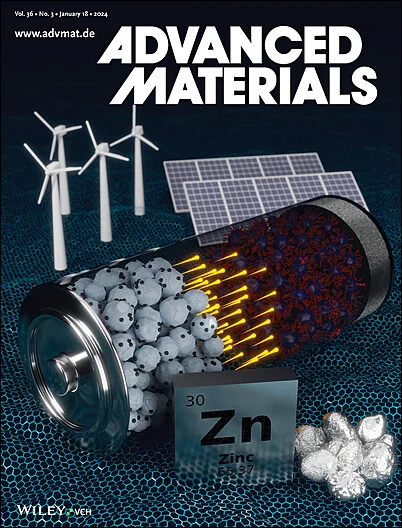In Situ Reconstructed Cu/Cu2+1O/ZnO Inverse Opals Accelerate Electrocatalytic Nitrate Reduction Kinetics for High Power Zn-NO3 - Battery.
IF 26.8
1区 材料科学
Q1 CHEMISTRY, MULTIDISCIPLINARY
引用次数: 0
Abstract
The electroreduction of NO3 - to NH3 (NO3RR) using renewable energy presents a promising strategy to mitigate environmental pollution and produce high-value chemicals. However, the practical application of NO3RR is hindered by limited active sites and sluggish reaction kinetics, stemming from the complex eight-electron process. Herein, a novel Cu/Cu2+1O/ZnO-2.5 inverse opals (CCZ-IOs-2.5) catalyst featuring a 3D porous network is designed, which provides abundant active sites and an optimized electronic structure to accelerate the NO3RR kinetics for efficient NH3 production. Experimental and theoretical calculations reveal that the introduction of ZnO facilitates electron transfer to Cu active sites, increasing charge density and lowering the reaction energy barrier of the rate-determining step (*NO to *NOH). As a result, CCZ-IOs-2.5 exhibits a notable enhancement in NH3 yield (from 0.255 to 0.313 mmol h-1 cm-2) and Faradaic efficiency (from 85.7% to 95.5%) compared to the Cu/Cu2+1O catalyst. Thanks to its excellent NO3RR activity, the Zn-NO3 - battery with the CCZ-IOs-2.5 cathode achieves a max power density of 11.93 mW cm-2. This study adopts a multi-dimensional strategy encompassing morphology regulation, electronic structure optimization, and surface/interface engineering, offering new insights into efficient electrocatalyst development and realizing integrated NH3 synthesis and energy output in a Zn-NO3 - battery.原位重构Cu/Cu2+ 10 /ZnO逆蛋白石加速高功率Zn-NO3 -电池电催化还原硝酸盐动力学
利用可再生能源将NO3 -电还原为NH3 (NO3RR)是一种很有前景的减轻环境污染和生产高价值化学品的策略。然而,由于复杂的八电子过程,活性位点有限,反应动力学缓慢,阻碍了NO3RR的实际应用。本文设计了一种新型的Cu/Cu2+ 10o /ZnO-2.5逆蛋白石(CCZ-IOs-2.5)催化剂,该催化剂具有三维多孔网络,提供丰富的活性位点和优化的电子结构,以加速NO3RR动力学,从而有效地产生NH3。实验和理论计算表明,ZnO的引入促进了电子向Cu活性位点的转移,增加了电荷密度,降低了速率决定步骤(*NO到*NOH)的反应能垒。结果表明,与Cu/Cu2+ 10催化剂相比,ccz - os -2.5的NH3产率(从0.255提高到0.313 mmol h-1 cm-2)和法拉第效率(从85.7%提高到95.5%)显著提高。由于具有优异的NO3RR活性,CCZ-IOs-2.5阴极的Zn-NO3 -电池的最大功率密度为11.93 mW cm-2。本研究采用了包括形貌调控、电子结构优化和表面/界面工程在内的多维策略,为高效电催化剂开发和实现Zn-NO3 -电池NH3合成与能量输出一体化提供了新的思路。
本文章由计算机程序翻译,如有差异,请以英文原文为准。
求助全文
约1分钟内获得全文
求助全文
来源期刊

Advanced Materials
工程技术-材料科学:综合
CiteScore
43.00
自引率
4.10%
发文量
2182
审稿时长
2 months
期刊介绍:
Advanced Materials, one of the world's most prestigious journals and the foundation of the Advanced portfolio, is the home of choice for best-in-class materials science for more than 30 years. Following this fast-growing and interdisciplinary field, we are considering and publishing the most important discoveries on any and all materials from materials scientists, chemists, physicists, engineers as well as health and life scientists and bringing you the latest results and trends in modern materials-related research every week.
 求助内容:
求助内容: 应助结果提醒方式:
应助结果提醒方式:


